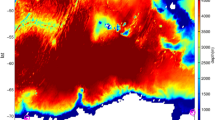Abstract
Brine drainage from sea ice formation plays a critical role in ocean mixing and seasonal variations of halocline in polar oceans. The horizontal scale of brine drainage and its induced convection is much smaller than a climate model grid and a model tends to produce false ocean mixing when brine drainage is averaged over a grid cell. A two-column ocean grid (TCOG) scheme was implemented in the Community Earth System Model (CESM) using coupled sea ice-ocean model setting to explicitly solve the different vertical mixing in the two sub-columns of one model grid with and without brine rejection. The fraction of grid with brine rejection was tested to be equal to the lead fraction or a small constant number in a series of sensitivity model runs forced by the same atmospheric data from 1978 to 2009. The model results were compared to observations from 29 ice tethered profilers (ITP) in the Arctic Ocean Basin from 2004 to 2009. Compared with the control run using a regular ocean grid, the TCOG simulations showed consistent reduction of model errors in salinity and mixed layer depth (MLD). The model using a small constant fraction grid for brine rejection was found to produce the best model comparison with observations, indicating that the horizontal scale of the brine drainage is very small compared to the sea ice cover and even smaller than the lead fraction. Comparable to models using brine rejection parameterization schemes, TCOG achieved more improvements in salinity but similar in MLD.
Similar content being viewed by others
References
Bitz C M, Holland M M, Weaver A J, Eby M (2001). Simulating the icethickness distribution in a coupled climate model. J Geophys Res, 106(C2): 2441–2463
Danabasoglu G, Bates S, Briegleb B P, Jayne S R, Jochum M, Large W G, Peacock S, Yeager S G (2012). The CCSM4 ocean component. J Clim, 25(5): 1361–1389
Duffy P, Eby M, Weaver A (1999). Effects of sinking of salt rejected during formation of sea ice on results of an ocean-atmosphere-sea ice climate model. Geophysical Research Letter, 26(12), 1739–1742
Fetterer F, Knowles K, Meier K, Savoie M (2002). Updated 2009. Sea Ice Index [ice extent]. Boulder: National Snow and Ice Data Center.
Hunke E C, Lipscomb W H, Turner A K, Jeffery N, Elliott S (2013). CICE: The Los Alamos Sea Ice Model Documentation and Software User’s Manual Version 5.0 LA-CC-06-012, Los Alamos National Laboratory, USA
Jin M, Hutchings J, Kawaguchi Y, Kikuchi T (2012). Ocean mixing with lead-dependent subgrid scale brine rejection parameterization in climate model. J Ocean Univ China, 11(4): 473–480
Kantha L H (1995). A numerical model of Arctic leads. J Geophys Res, 100(C3): 4653–4672
Lake R A, Lewis E L (1970). Salt rejection by sea ice during growth. J Geophys Res, 75(3): 583–597
Large W, Danabasoglu G, Doney S, McWilliams J (1997). Sensitivity to surface forcing and boundary layer mixing in the NCAR CSM ocean model: annual-mean climatology. J Phys Oceanogr, 27(11): 2418–2447
Large W G, McWilliams J C, Doney S C (1994). Oceanic vertical mixing: a review and a model with a vertical K-profile boundary layer parameterization. Rev Geophys, 32(4): 363–403
Large W G, Yeager S G (2009). The global climatology of an interannually varying air-sea flux data set. Clim Dyn, 33(2–3): 341–364
Matsumura Y, Hasumi H (2008). Brine-driven eddies under sea ice leads and their impact on the Arctic Ocean mixed layer. Journal of Physical Oceanography, 38: 146–163
Morison J H (1993). The lead experiment. Eos Trans AGU, 74(35): 393–397
Nguyen A T, Menemenlis D, Kwok R (2009). Improved modeling of the Arctic halocline with a subgrid-scale brine rejection parameterization. J Geophys Res, 114(C11): C11014
Steele M, Morley R, Ermold W (2001). PHC: a global ocean hydrography with a high quality Arctic Ocean. J Clim, 14(9): 2079–2087
Toole J M, Timmermans M L, Perovich D K, Krishfield R A, Proshutinsky A, Richter-Menge J A (2010). Influences of the ocean surface mixed layer and thermohaline stratification on Arctic Sea ice in the central Canada Basin. J Geophys Res, 115(C10): C10018
Wakatsuchi M, Ono N (1983). Measurements of salinity and volume of brine excluded from growing sea ice. J Geophys Res, 88(C5): 2943–2951
Wettlaufer J S, Worster M C, Huppert H E (1997). The phase evolution of young ice. Geophys Res Lett, 24(10): 1251–1254
Zhang J, Steele M (2007). Effect of vertical mixing on the AtlanticWater layer circulation in the Arctic Ocean. J Geophys Res, 112(C4): C04S04
Author information
Authors and Affiliations
Corresponding author
Rights and permissions
About this article
Cite this article
Jin, M., Hutchings, J. & Kawaguchi, Y. Sensitivity study of subgrid scale ocean mixing under sea ice using a two-column ocean grid in climate model CESM. Front. Earth Sci. 9, 594–604 (2015). https://doi.org/10.1007/s11707-014-0489-9
Received:
Accepted:
Published:
Issue Date:
DOI: https://doi.org/10.1007/s11707-014-0489-9



